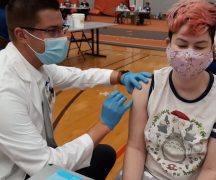By JAN LARSON McLAUGHLIN
BG Independent News
Wood County residents have gotten fatter and sadder in the last three years.
The latest Community Health Assessment results for Wood County adults show growing numbers of people carrying around extra weight physically and mentally. Nearly 40 percent of local adults classify themselves as obese, while another 33 percent say they are overweight. A total of 14 percent of adults reported feeling sad or hopeless for two or more consecutive weeks.
The surveys are conducted every three years by the Hospital Council of Northwest Ohio.
“We can be confident that this is pretty accurate,” Wood County Health Commissioner Ben Batey said earlier this week.
A total of 1,200 adult surveys were mailed out to randomly selected residences. In order to be statistically accurate, 383 responses were needed. A total of 431 adults responded. The youth surveys fared even better, since they were conducted at schools.
The health survey process began in 2008 – which allows the health department make comparisons to past health data.
“How are we trending? Are we getting better in this trending?” Batey asked.
The answer is yes and no.
Overall, the youth data is positive.
“I was very happy to see the trends with our youth,” Batey said. “We’re either holding the line or improving.”
Obesity and overweight numbers among youth are gradually improving. Physical activity among youth is increasing.
“Those are good things to see,” he said.
Cigarette smoking among youth is at a record low. Overall substance abuse is down in kids. The numbers of youth trying alcohol and engaging in binge drinking are also down. Adolescent sexual activity is down. And bullying has dropped a bit.
The one area seeing a troubling increase is in mental health. More youth responded that they have considered suicide, and experience regular sadness or hopelessness.
“Mental health still seems to be declining,” Batey said. “It’s a trend that’s going in the wrong direction.”
In the survey responses of parents with children ages birth to 5, a positive trend was seen in a majority of families reading to children every day in the past week. The biggest negative was a drop in mothers attempting breastfeeding.
“That jumped off the page for me,” Batey said. “I think that’s huge.”
But overall, Batey was happy about changes seen in younger respondents.
“I’m very optimistic about the trends we’re seeing in our children and youth,” he said.
Adults, on the other hand, slipped in some key areas especially weight and mental health. A total of 39 percent of adults ranked themselves as obese, compared to 22 percent three years ago. That compares to 32 percent of Ohioans and 30 percent overall in the U.S. that consider themselves as obese. Combined, 72 percent of local adults described themselves as either overweight or obese.
“That’s a pretty big swing for us from where we were,” Batey said. “That’s a pretty significant number that’s concerning to me.”
Wood County adults also showed a decline in mental health. When asked for the average number of days of poor mental health in the past month, local adults said 4.8 compared to 1.9 in 2015.
When asked about having two or more weeks in a row of feeling sad or hopeless, 14 percent of adults said they had experienced that, compared to 5 percent in 2015.
Those growing numbers are also reflected nationally, Batey said. Some credit more awareness and willingness to talk about mental health issues. Some blame the use of social media which has led to fewer personal connections with people.
Now that the latest Community Health Assessment numbers are in, a plan will be devised to respond.
“We’ll work with the community to come up with a Community Health Improvement Plan,” Batey said. That plan will determine the areas that should be focused on, and the best practices to have a positive impact.
The health department recently started a physical activity push that encourages people to get out and use their local community parks.
Since residents identified time and weather as deterrents to exercising, Batey said the next effort may be to get people to work out while watching TV. “There are things you can do right in your living room,” he said.
As of Aug. 1, the results of the health survey will be posted on the Wood County Health Department’s website. Batey is hoping residents will read it and send in suggestions.
“We’re always looking for feedback from the community,” he said. “We want this to be usable data for people. So that when we measure again, hopefully we see improvements.”
Following are some further Wood County health ranking comparisons with previous years, and with state and national numbers:
ADULTS
Binge drinking (defined as consuming more than four drinks for women, or five drinks for men) on a single occasion in the past 30 days:
- 27 percent in 2018
- 24 percent in 2012
- 18 percent in Ohio
- 17 percent in U.S.
Current smoker:
- 11 percent in 2018
- 23 percent in 2008
- 23 percent in Ohio
- 17 percent in U.S.
Rated health as excellent or very good:
- 52 percent in 2018
- 62 percent in 2012
- 51 percent in Ohio
- 52 percent in U.S.
Rated health as fair or poor:
- 14 percent in 2018
- 9 percent in 2012
- 18 percent in Ohio
- 17 percent in U.S.
Rated their mental health as not good on four or more days in the previous month:
- 32 percent in 2018
- 16 percent in 2015
Adults who used marijuana in past six months:
- 6 percent in 2018
- 3 percent in 2015
Had more than one sexual partner in the past year:
- 7 percent in 2018
- 2 percent in 2015
Two or more weeks in a row felt sad or hopeless:
- 14 percent in 2018
- 5 percent in 2015
Limited in some way because of a major impairment or health problem:
- 38 percent in 2018
- 25 percent in 2015
YOUTH
Described themselves as slightly or very overweight:
- 16 percent of teens in 2018
- 20 percent of older teens in 2018
Seriously considered attempting suicide in the past 12 months:
- 19 percent of teens in 2018
- 9 percent of teens in 2012
Ever tried cigarette smoking:
- 14 percent of teens in 2018
- 35 percent of teens in 2008
- 23 percent of older teens in 2018
- 29 percent of older teens in U.S.
Current smokers:
- 3 percent of teens in 2018
- 15 percent of teens in 2008
- 6 percent of older teens in 2018
- 9 percent of older teens in U.S.
Ever tried alcohol:
- 38 percent of teens in 2018
- 61 percent of teens in 2008
- 52 percent of older teens in 2018
- 60 percent of older teens in U.S.
Current drinker (at least one drink of alcohol in last 30 days):
- 15 percent of teens in 2018
- 30 percent of teens in 2008
- 23 percent of older teens in 2018
- 30 percent of older teens in U.S.
Binge drinking in last 30 days:
- 7 percent of teens in 2018
- 21 percent of teens in 2008
- 11 percent of older teens in 2018
- 14 percent of older teens in U.S.
Drank for first time before age 13:
- 10 percent in 2018
- 24 percent in 2008
- 16 percent in U.S.
Rode with a driver who had been drinking alcohol:
- 12 percent of teens in 2018
- 18 percent of teens in 2008
- 14 percent of older teens in 2018
- 17 percent of older teens in U.S.
Drove when they had been drinking alcohol:
- 1 percent in 2018
- 6 percent in 2008
- 6 percent in U.S.
Youth who used marijuana in the last month:
- 9 percent in 2018
- 8 percent in 2008
- 14 percent of older teens
- 20 percent of older teens in U.S.
Ever had sexual intercourse:
- 20 percent in 2018
- 31 percent in 2008
- 35 percent of older teens in 2018
- 40 percent of older teens in U.S.
Carried a weapon:
- 9 percent in 2018
- 10 percent in 2008
- 10 percent of older teens in 2018
- 16 percent of older teens in U.S.
Bullied in the past year:
- 37 percent in 2018
- 46 percent in 2008
Physically hurt on purpose by boyfriend or girlfriend in past year:
- 2 percent in 2018
- 6 percent in 2012
- 4 percent of older teens in 2018
- 8 percent of older teens in U.S.





